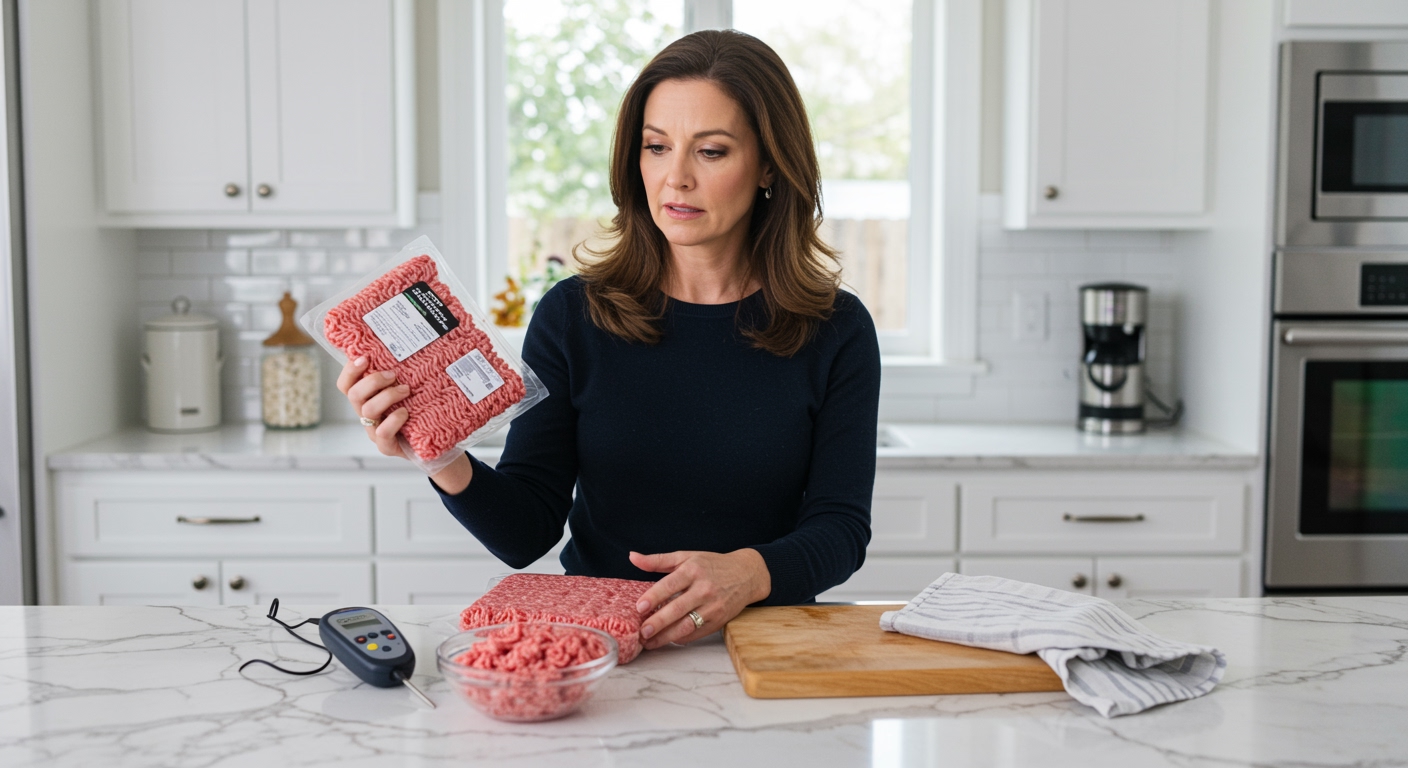✪ Key Highlight: Grey ground beef can still be safe to eat if it smells normal and lacks sliminess, experts confirm.
Introduction
You open your refrigerator and find that package of ground beef has turned an unappetizing grey color.
Your first instinct tells you to throw it away immediately because grey meat must be spoiled.
Hi, I’m Abdur, your nutrition coach and today I’m going to analyze this important food safety news about whether grey ground beef is actually dangerous to eat.
Why Does Ground Beef Turn Grey?
Fresh ground beef naturally changes color through a process called oxidation when exposed to air.
The meat starts with a purplish-red color but transforms to bright red within just fifteen minutes of air exposure.
This red color comes from myoglobin, a protein in muscle tissue that carries oxygen to muscle cells.
After several days of continued oxidation, the meat’s pigment continues reacting with oxygen and eventually turns grey.
The center of packaged ground beef often appears more brown than the surface because it has been exposed to less oxygen than the outside portions.
This color variation within the same package is completely normal and does not indicate spoilage.
Understanding this natural process helps you make better decisions about meat safety instead of relying solely on visual appearance.
✪ Fact: Ground beef can turn grey in as little as five days due to natural oxidation processes.
How Do You Know If Grey Beef Is Safe?
Food safety experts emphasize that smell and texture are much more reliable indicators than color alone.
If your grey ground beef smells normal and feels firm rather than slimy, it is usually safe to cook and eat.
Fresh beef should have a neutral, slightly metallic smell that is not unpleasant or offensive.
Spoiled meat develops a distinctly sour or rotten odor that becomes obvious when you open the package.
The texture test involves gently pressing the meat with clean fingers to check for sliminess.
Good ground beef feels firm and slightly moist but never sticky or slimy to the touch.
When bacteria begin growing on meat, they produce enzymes that break down proteins and create that characteristic slimy coating.
✪ Pro Tip: Trust your nose first, then check texture before making any decisions about meat safety.
What Temperature Kills Harmful Bacteria?
The USDA recommends cooking ground beef to an internal temperature of 160 degrees Fahrenheit or 71 degrees Celsius.
This temperature effectively destroys harmful bacteria like E. coli, Salmonella, and other pathogens that might be present.
Using a food thermometer is the only reliable way to ensure your meat reaches this safe temperature throughout.
Visual cues like color changes are not dependable indicators of doneness because ground beef can still appear pink even when fully cooked.
Insert the thermometer into the thickest part of the meat, whether you are making burgers, meatballs, or meat loaf.
The high temperature breaks down bacterial cell walls and denatures proteins that allow harmful microorganisms to survive.
Proper cooking transforms potentially dangerous raw meat into safe, nutritious food that supports your health goals.
✪ Note: A food thermometer is essential equipment for safe ground beef preparation at home.
How Should You Store Ground Beef?
Mark the purchase date on your ground beef package immediately to track how long it has been stored.
Fresh ground beef stays good in the refrigerator for only one to two days after purchase.
Freeze ground beef immediately if you do not plan to use it within this short timeframe.
Properly frozen ground beef maintains quality for up to four months in a standard home freezer.
Thaw frozen ground beef completely in the refrigerator rather than at room temperature to prevent bacterial growth.
Room temperature thawing allows the outer portions to reach dangerous temperatures while the center remains frozen.
This temperature variation creates ideal conditions for harmful bacteria to multiply rapidly on the surface layers.
✪ Pro Tip: Always thaw ground beef in the refrigerator overnight for maximum safety and quality.
When Should You Definitely Throw It Away?
Discard ground beef immediately if it develops a sour, rotten, or ammonia-like smell.
These odors indicate that harmful bacteria have begun breaking down the meat proteins and producing toxic compounds.
A sticky or slimy texture on the surface means bacterial growth has progressed beyond safe levels.
Ground beef that has been stored in the refrigerator for more than two days should be discarded regardless of appearance.
Any meat involved in a recall announcement should be thrown away immediately, even if it looks and smells normal.
Recalls happen when testing reveals dangerous bacteria like E. coli in specific production batches.
Eating contaminated meat can cause serious foodborne illness, especially in children, elderly people, and those with compromised immune systems.
✪ Note: When in doubt about meat safety, it is always better to discard it than risk illness.
The Bottom Line
Grey ground beef is not automatically unsafe to eat if it passes the smell and texture tests.
Color changes are natural but your senses are the best food safety tools you have.
Share your thoughts about food safety practices or any questions you have about ground beef storage in the comments below.
References
At NutritionCrown, we use quality and credible sources to ensure our content is accurate and trustworthy. Below are the sources referenced in creating this article:
- Food Bible: Officials Explain Why Dangerous Eat Raw Undercooked Beef
- Food Bible: Expert Reveals Whether Safe Eat Ground Grey Beef
- Cozy Meal: Ground Beef Recall
- AOL: Safe Eat Ground Beef Turned





